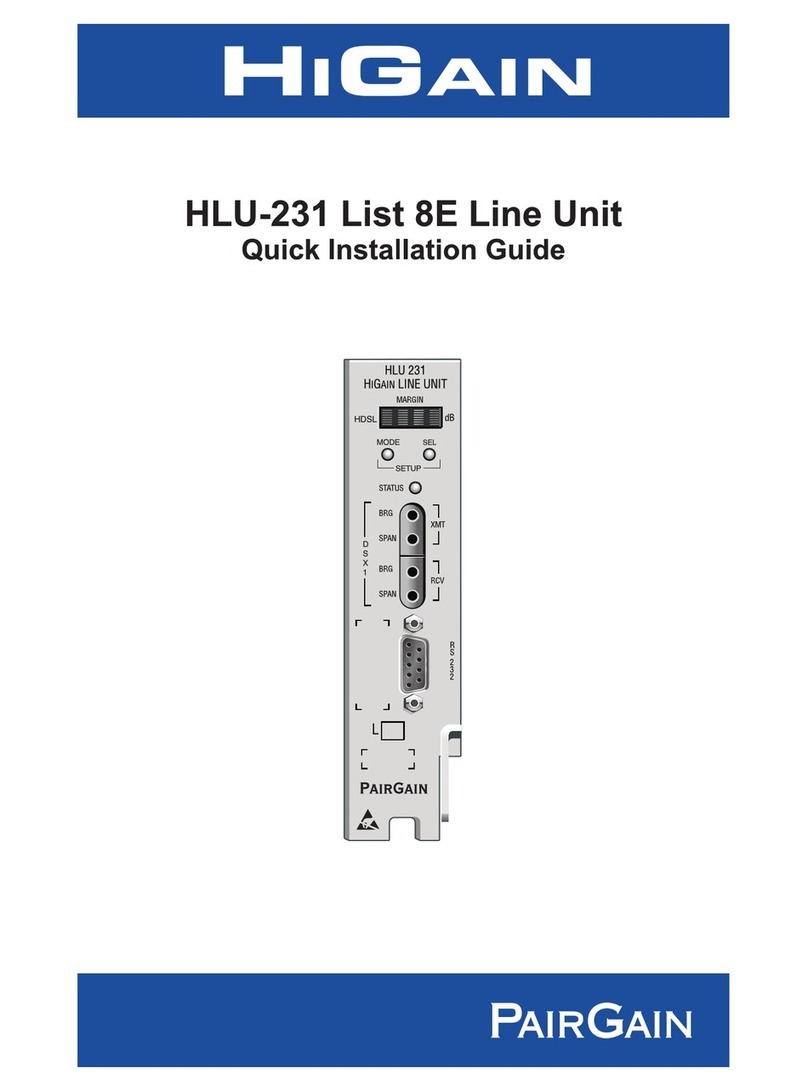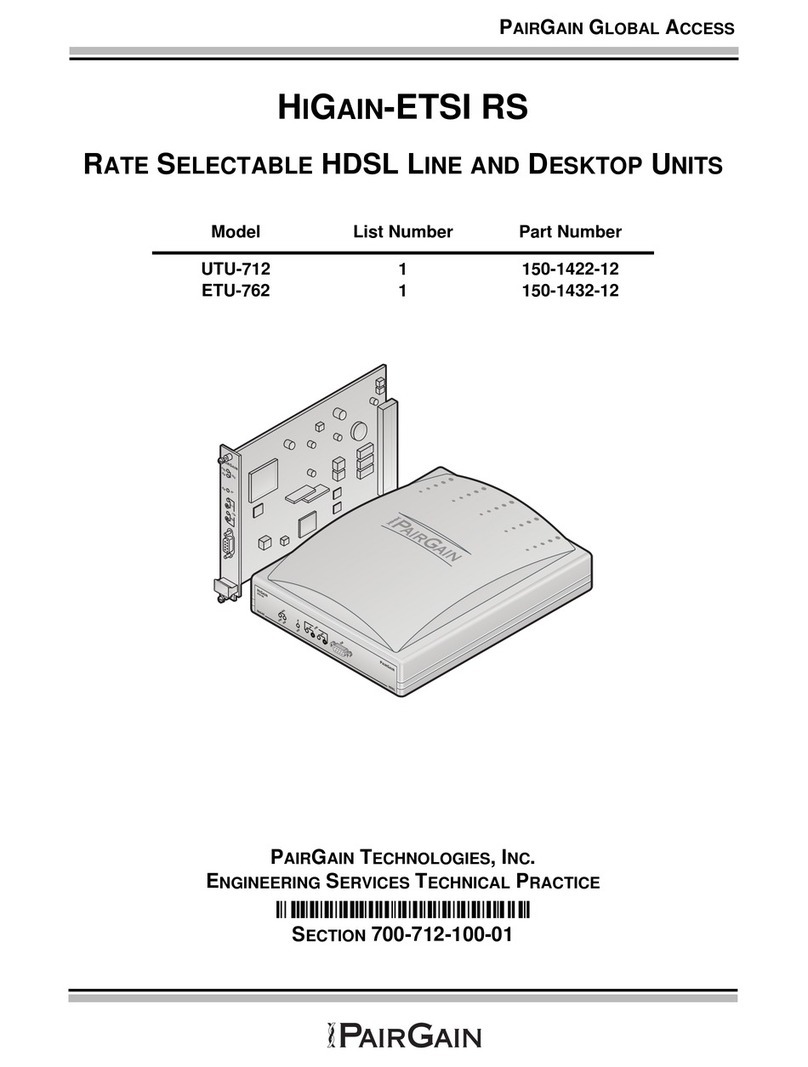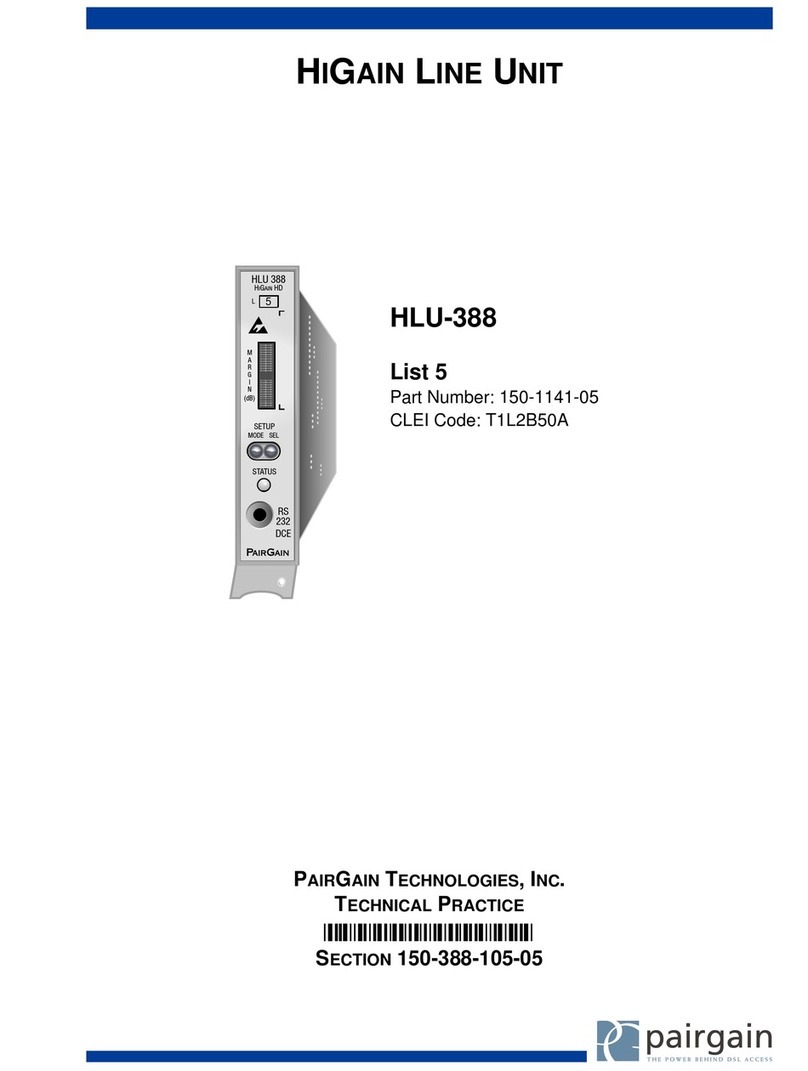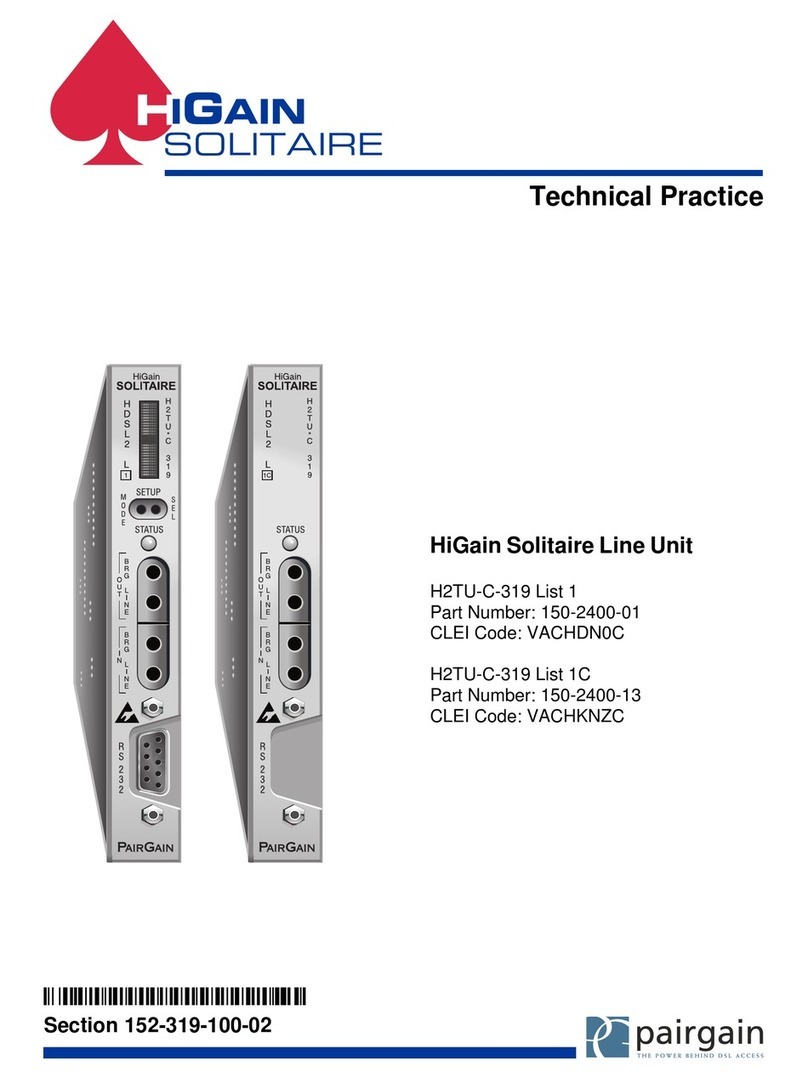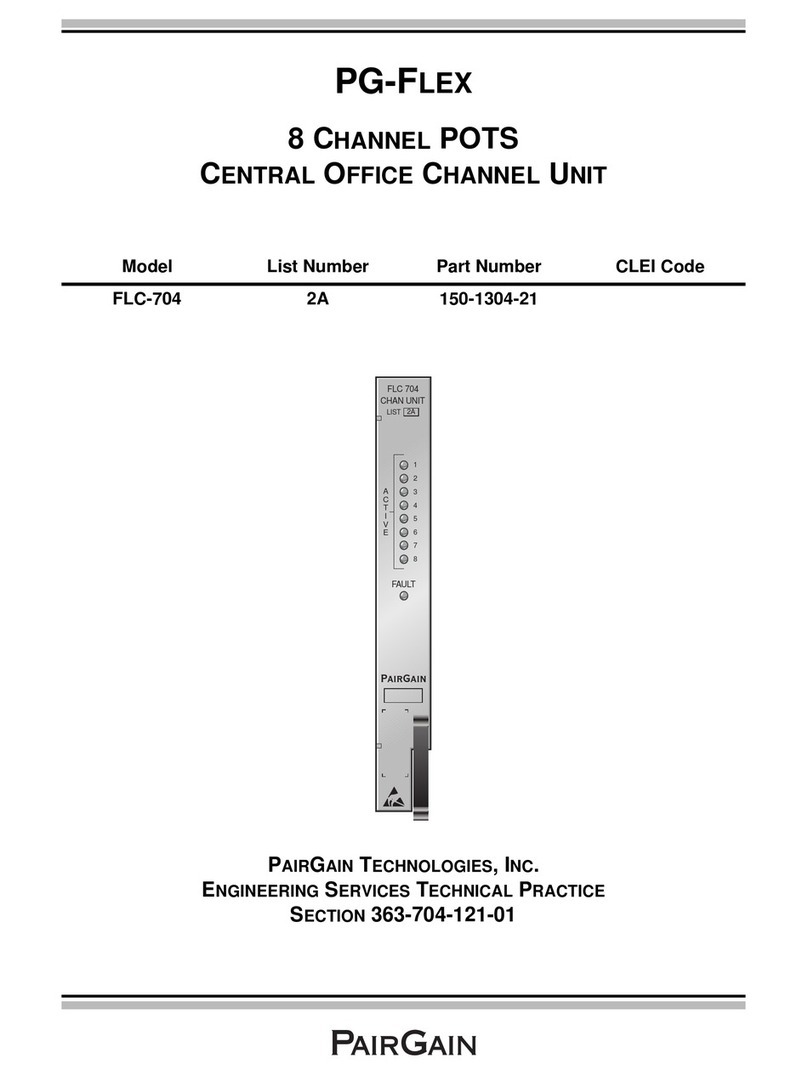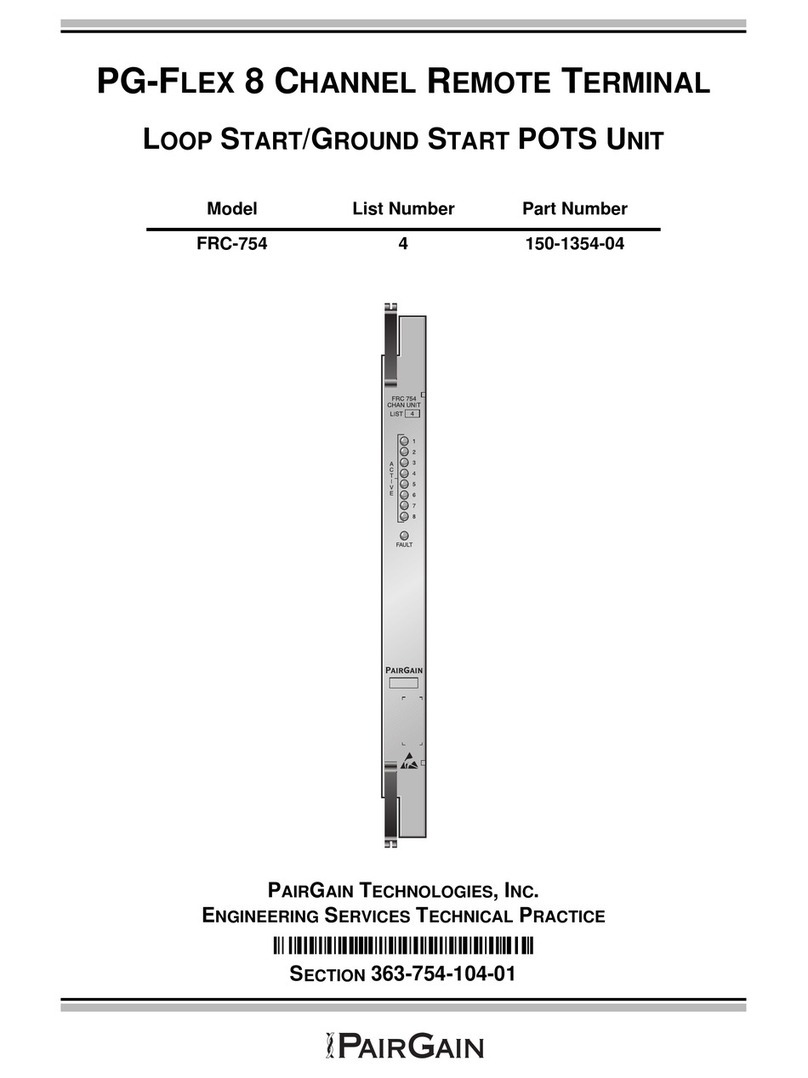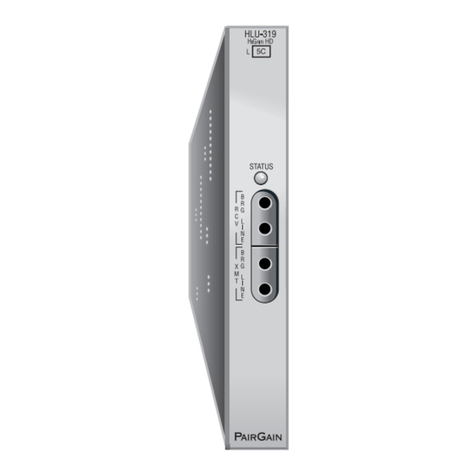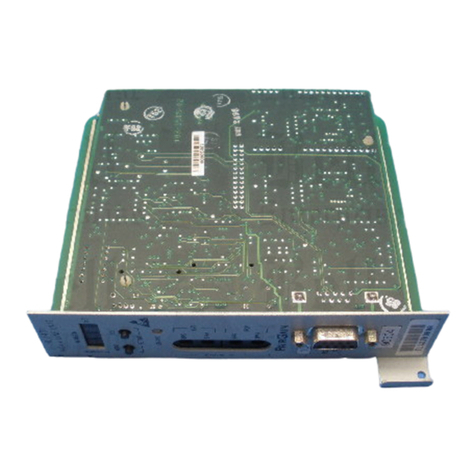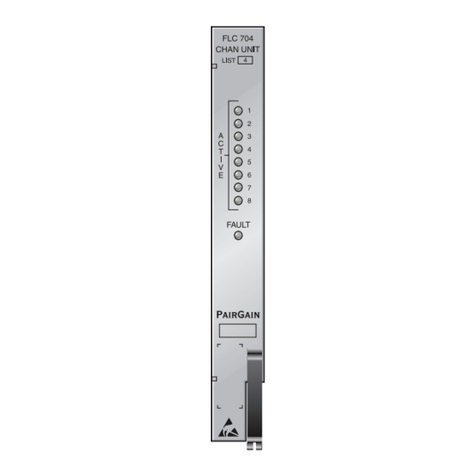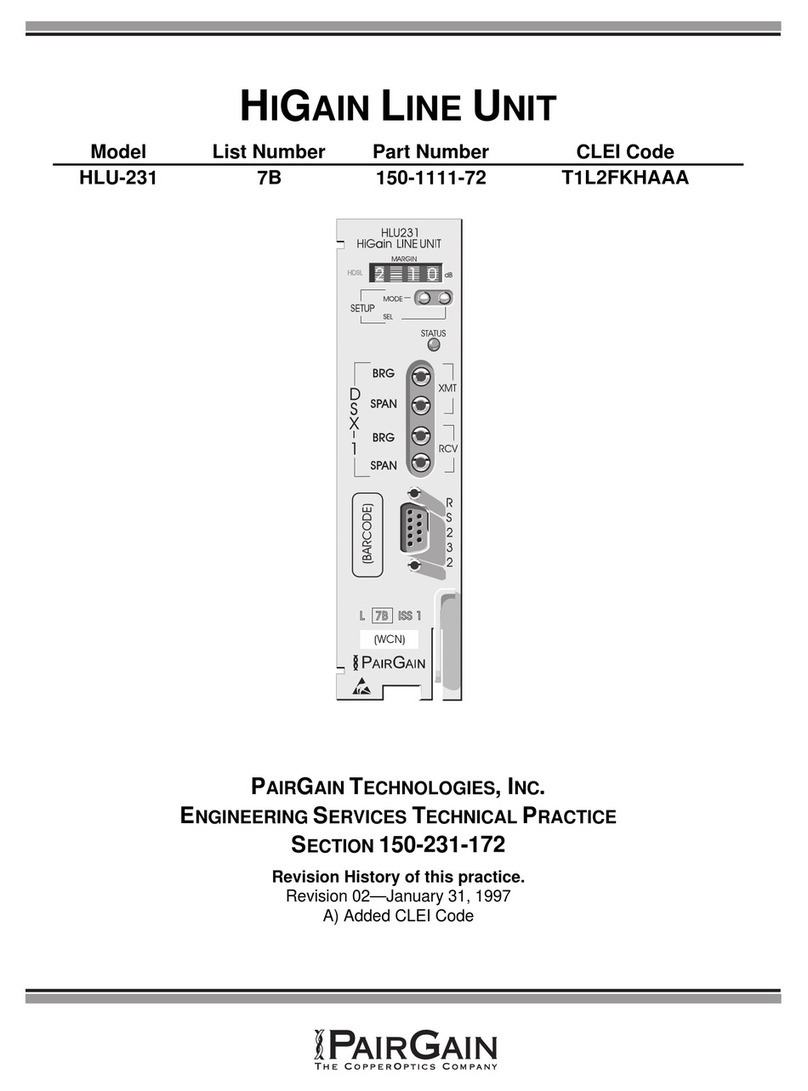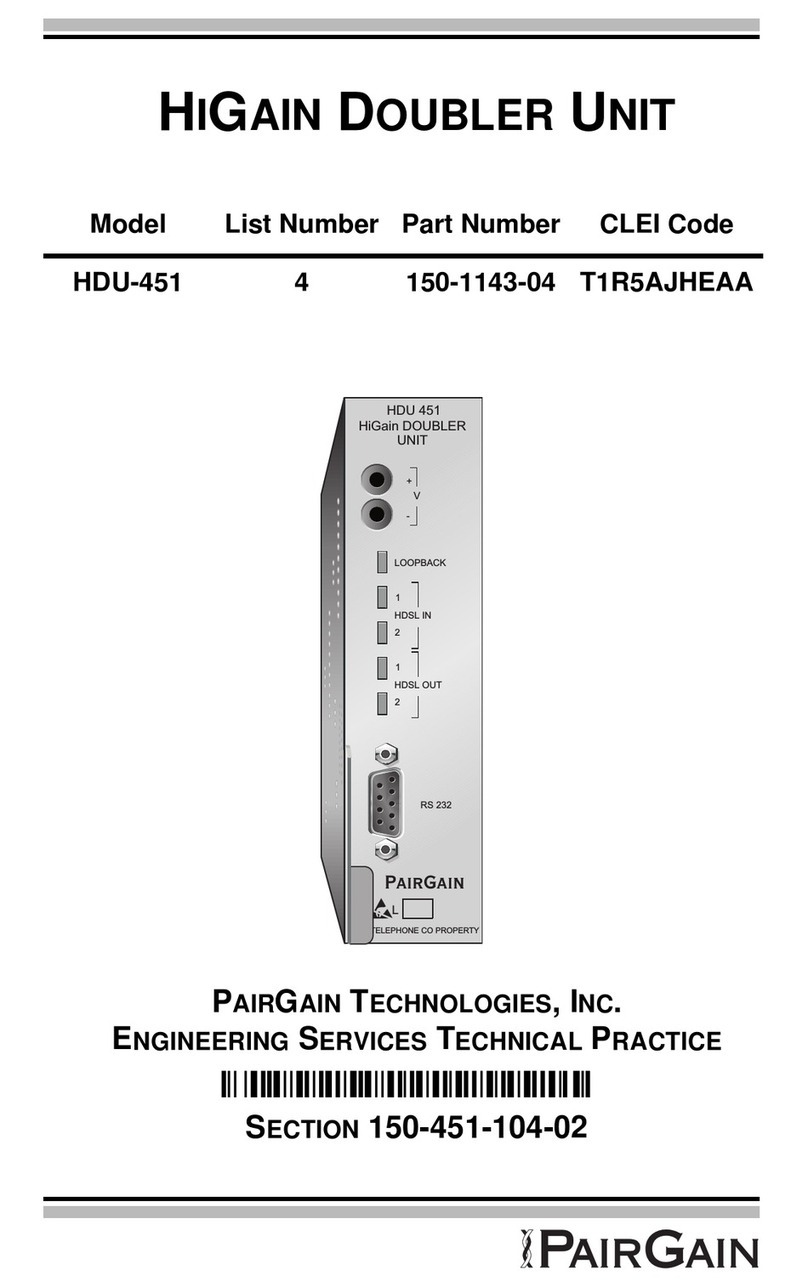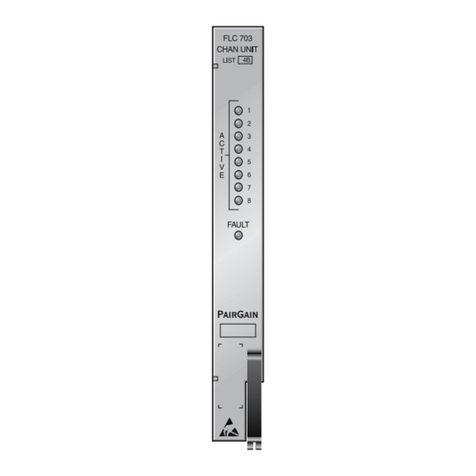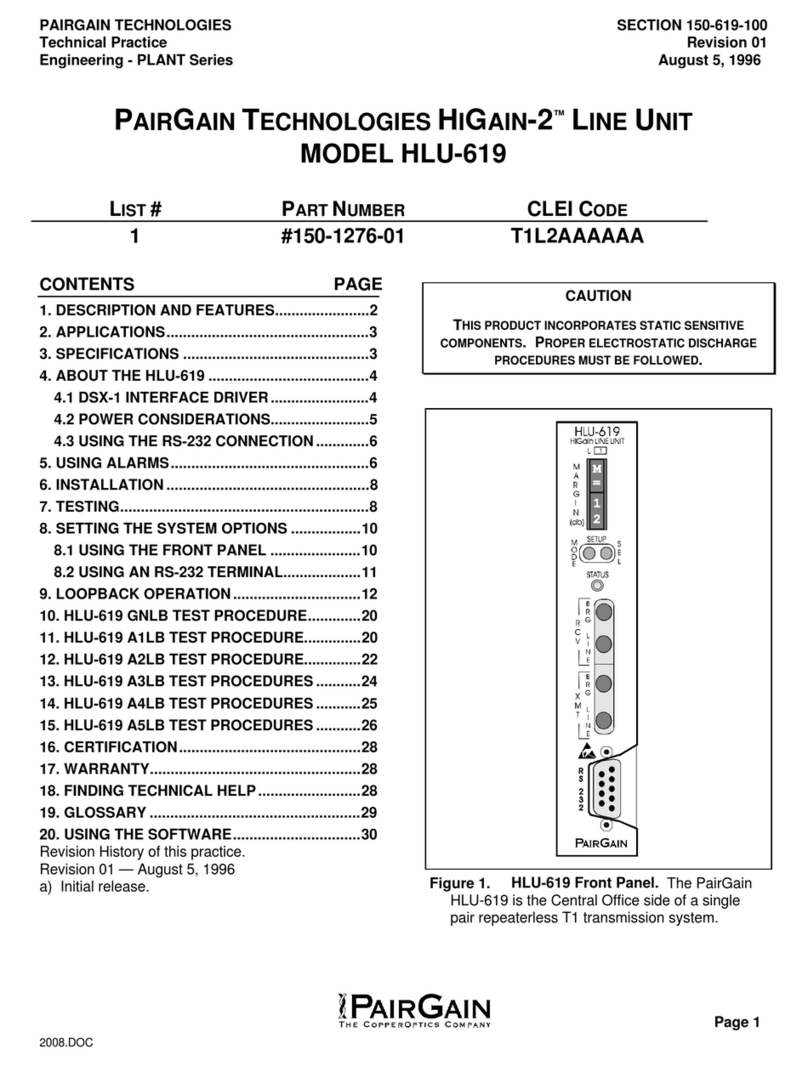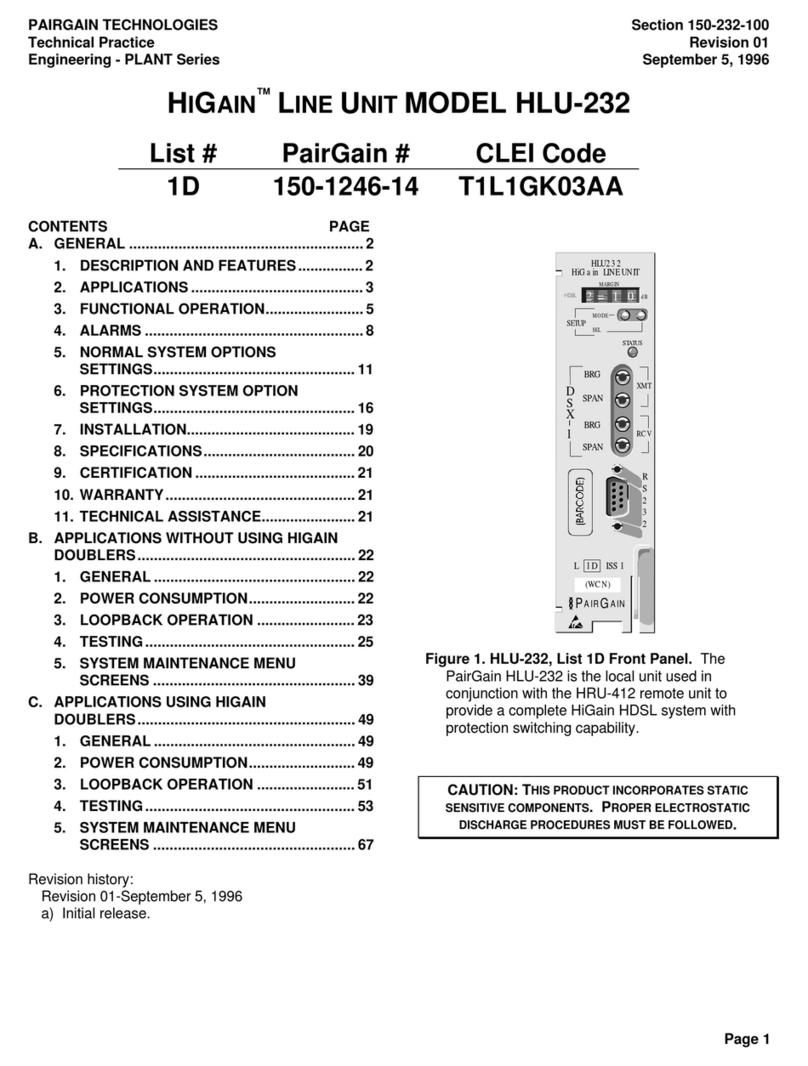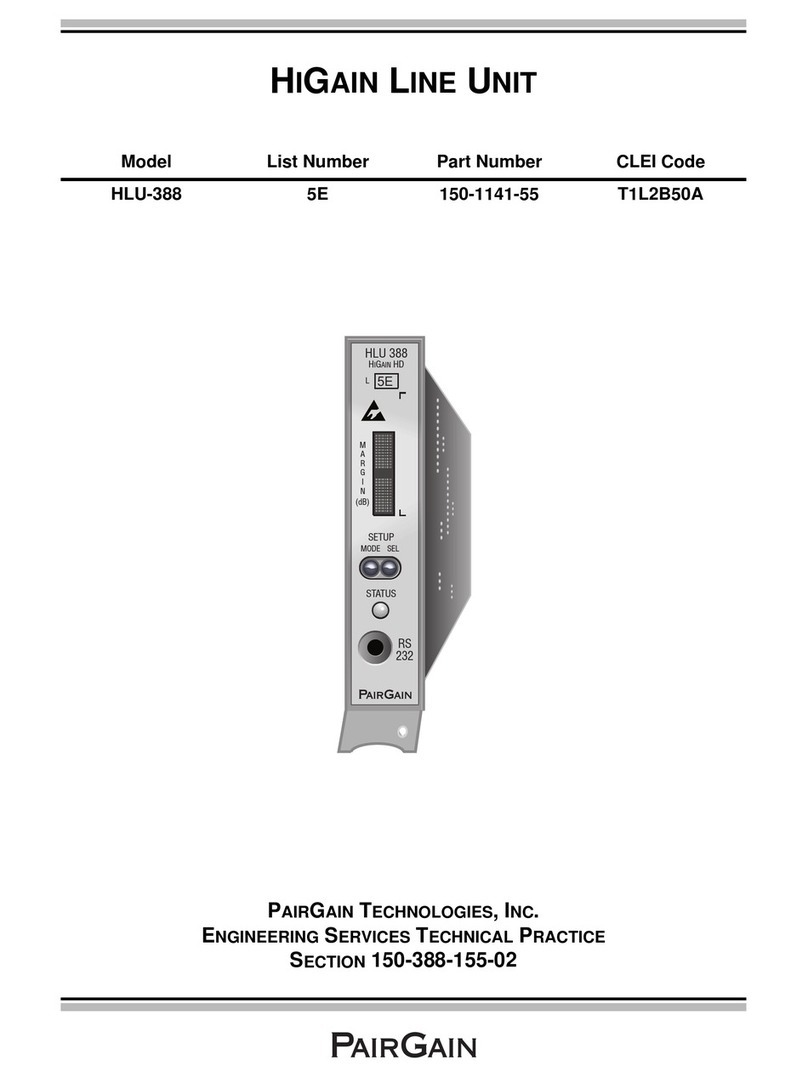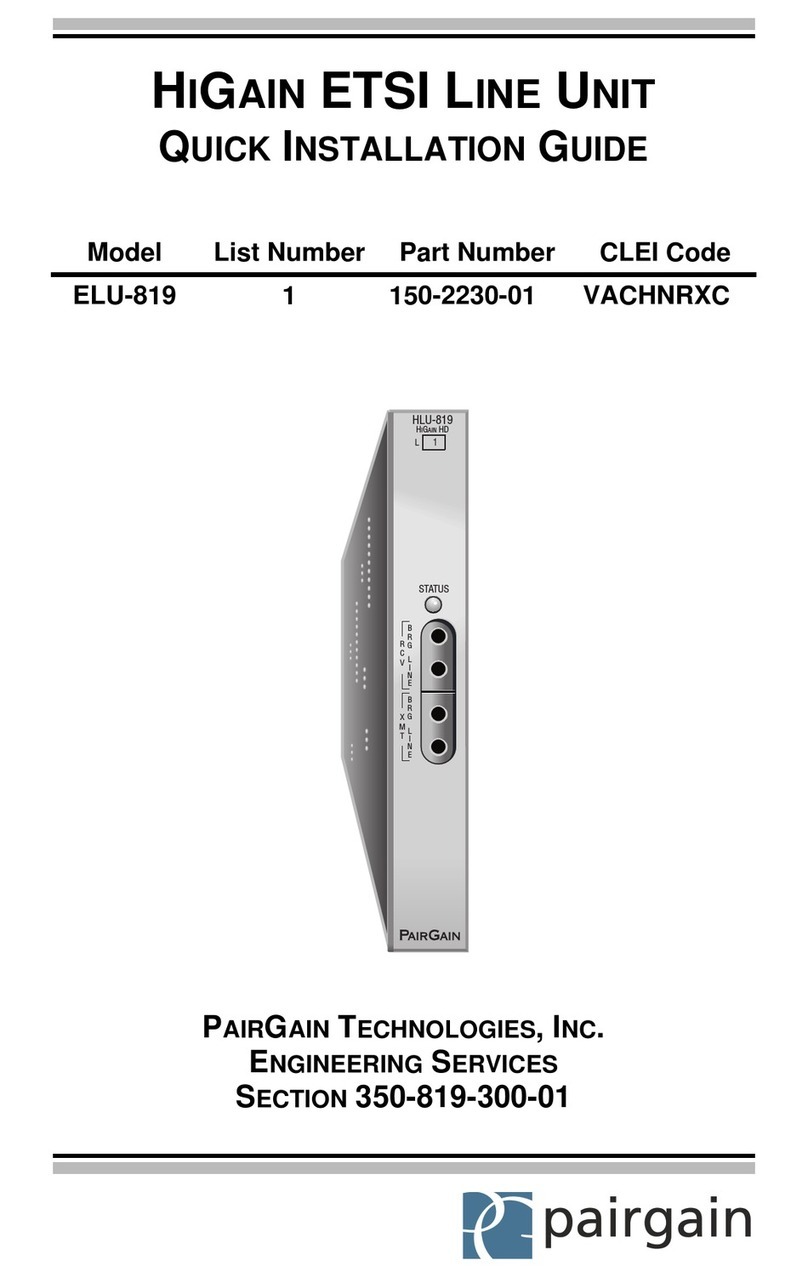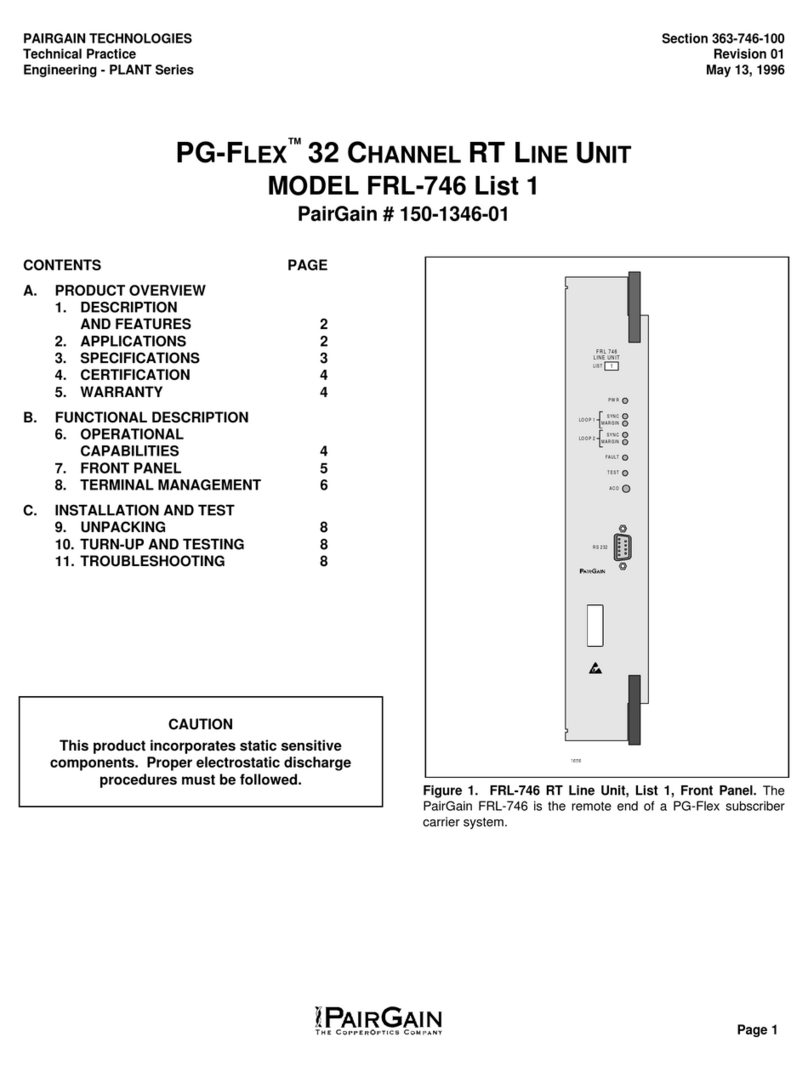
LOOPBACK TESTING
Initiate loopback testing from the HiGain maintenance menus or use the MODE and SEL
buttons. The hexidecimal inband codes shown below can be sent by a test set.
GNLB Loopback Commands
Loopback Inband Code Description
NLOC 1111000 DSX-1 signal is looped back to the network at the HLU.
NDU1 110000 DSX-1 signal is looped back to the network at the HDU1.
NDU2 111000 DSX-1 signal is looped back to the network at the HDU2.
NDU3 1010001 DSX-1 signal is looped back to the network at the HDU3.
NDU4 1010010 DSX-1 signal is looped back to the network at the HDU4.
NREM 1110000 DSX-1 signal is looped back to the network at the HRU.
SMJK 11000 DSX-1 signal is looped back to the network at the HRU SmartJack
module.
CLOC 1111100 Signal from customer is looped back to the customer at the HLU.
CDU1 111100 Signal from customer is looped back to the customer at the HDU1.
CDU2 111110 Signal from customer is looped back to the customer at the HDU2.
CDU3 1011001 Signal from customer is looped back to the customer at the HDU3.
CDU4 1011010 Signal from customer is looped back to the customer at the HDU4.
CREM 1111110 Signal from customer is looped back to the customer at the HRU.
Loopdown 11100 Deactivates any of the above loopbacks.
For more detailed information about the Maintenance Terminal
screens, provisioning, and loopback mode testing, refer to the
HLU-388 List 5A technical practice, document number
150-388-151-xx. It can be downloaded from the Customer Site portion
of the PairGain Web page at www.pairgain.com. A password is
required to access the Customer Site Web pages. If you do not have
a password, contact your PairGain sales representative.
Front-Panel Alarm Messages(a)
(a) Alarm (ALRM) displays prior to an alarm message. Pressing the SEL button initiates an Alarm Cutoff (ACO)
message.
Message Description
LOSW Indicates that one of the HDSL loops has lost sync.
LLOS Indicates that no signal is detected at the DSX-1 input to the HLU.
RLOS Indicates that no signal is detected at the DS-1 input to the HRU.
BER A system Bit Error Rate alarm is in effect.
MAL1 or MAL2 The margin on HDSL Loop 1 or Loop 2 has dropped below the threshold set by the user.
NONE No alarm present.
System Configuration Codes
Code Description
VER xxxx The release revision of the firmware (appears during the System Settings review mode).
LIST xxxx The model number of the product (appears during the System Settings review mode).
FRM xxxx Indicates the type of frame pattern being received from the DSX-1, where xxxx is SF,
ESF, UNFR, or NONE).
CODE xxxx The line code setting, where xxxx is Alternate Mark Inversion (AMI) or Bipolar with
8-Zero Substitution (B8ZS).
PLEV xxxx Indicates the HDSL line voltage in its LOW (-140 Vdc), HIGH (±112 Vdc), or DIS
(disabled).
Front-Panel Diagnostic Messages
Message Description (normal operating messages in bold)
1=xx or 2=yy Indicates the power of the received HDSL signal on each loop relative to noise. Any value
of 06 (dB) or greater is adequate for reliable system operation.
ACQ1 or ACQ2 The multiplexers of the HLU and the HRU or the first doubler are trying to establish
synchronization over Loop 1 or Loop 2 of Span 1.
AnL1 or AnL2 The multiplexers ofthe two deviceson Spannare trying to establish synchronization with
each other on Loop 1 or Loop 2, where nis the number of the span.
BAD RT? The HLU is not receiving any response from the HRU.
DSO NONE = no DSO channels blocked. BLK = some channels blocked.
FERR Framing bit error occurred at HLU DSX-1 input.
H1ES or H2ES HDSL Loop 1 or Loop 2 CRC error.
nHDU Indicates the number (n) of doublers in the circuit (if any are present).
INSL xxdB The maximum Insertion Loss message (INSL) appears followed by xxdB, where xx is the
maximum insertion in dB of all spans and loops.
LBPV A local bipolar violation has been received at the DSX-1 input to the HLU-388 List 5A.
MNGD The HLU is under control of the HMU-319 network management unit.
PWR FEED GND One of the HDSL loops has been grounded.
PWR FEED ON Indicates that the HDSL loops are not grounded or shorted.
PWR FEED OFF HDSL span power has been turned off.
PWR FEED SHRT Indicates a short between the two HDSL pairs or the inability of the HRU to communicate
with the HLU.
SELF TEST The HLU is in a self-test mode. This occurs every power on/off cycle.
SIG1 or SIG2 The transceivers of the HLU and HRU or first doubler are trying to establish contact with
each other on Loop 1 or Loop 2 of Span 1.
SnL1 or SnL2 The transceivers of the two devices on Span nare trying to establish contact with each
other on Loop 1 or Loop 2, where nis the number of the span.
TLOS HRU is in a logic loopback state caused by a loss of its T1 input from the CI.
System Settings
Display Code Description (default values in bold)
EQL Sets the Equalizer (EQL) DSX-1 to: 0 (0 to 133 ft.), 133 (133 to 266 ft.), 266 (266 to 399
ft.), 399 (399 to 533 ft.), 533 (533 to 655 ft.).
LPBK Enables (ENA) or disables (DIS) all inband SMJK loopback commands.
SPLB Configures the system for generic inband loopback commands (GNLB) or special
loopback commands (A1LB, A2LB, A3LB, A4LB, A5LB).
PWRF DIS = disables HDSL powering.
LOW = HDSL line voltage at -140 Vdc maximum.
AUTO = automatically switches between -140 Vdc for non-doubler applications and
±112 Vdc for doubler applications.
HIGH = ±112 Vdc for all applications.
ZBTS ON = ESF frame is operating in its Zero-Byte Time Slot Interchange (ZBTSI) mode.
OFF = ESF frame is operating in its normal non-ZBTSI mode.
BERT NONE = prevents generation of a system alarm due to excessive BER.
1E-6 or 1E-7 = alarm activates when BER threshold exceeds 10-6 or 10- 7, respectively.
LBTO Loopback timeout = NONE, 20, 60, 120 minutes.
DS1 Line code = , AUTO, B8ZS, or AMI.
FRMG Framing = AUTO or UNFR (unframed).
HAIS Transmits the AIS signal at the HLU and HRU output ports if one (1LP) or both (2LP) HDSL
loops are not in sync.
SAIS Enables (ENA) or disables (DIS) NREM/SMJK loopback mode.
DSO DSO blocking on (BLK) or off (NONE); can only be set through the Maintenance Terminal.
MARG 0 to 15 dB; default is 4dB; can only be set through the Maintenance Terminal.
RDA Enables (ENA) or disables (DIS) remote DS1 LOS at HRU input.
ALMP Enables line to output an (AIS) payload or an (LOS) condition.
RTPV Enables (ENA) or disables (DIS) remote provisioning.
BPVT Enables (ENA) or disables (DIS) bipolar violation transparency (BVP).
CONF YES = confirms that all operating modes are to be updated to their current selections.
NO = prevents the most recently selected operating mode selection from being updated.
